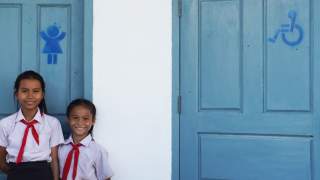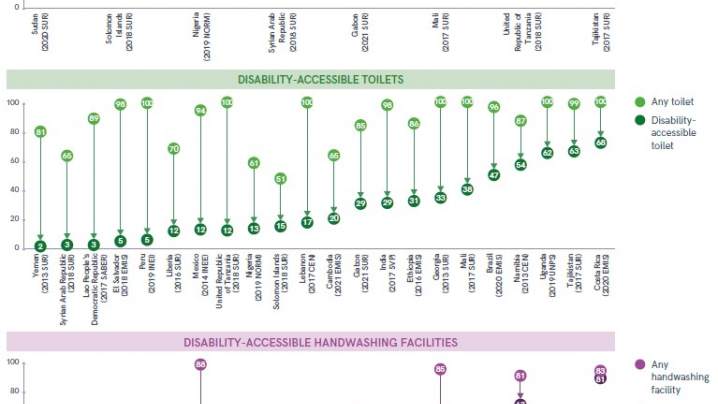Disability-inclusive drinking water, sanitation, and hygiene services in schools are critical to achieving a safe and inclusive learning environment for all.

Defining disability-inclusive
Disability is not merely a medical condition or diagnosis but rather a failure of the policy, cultural and physical environments to accommodate differences in function. According to the Convention on the Rights of Persons with Disabilities, ‘disability’ is a complex and evolving concept which stems from the interaction between certain conditions or impairments and an unaccommodating environment that hinders an individual’s full and effective participation in society on an equal basis with others.
Disability-inclusive education means that schools are capable of receiving children with disabilities and meeting their needs. This includes that school infrastructure (buildings, classrooms, toilets, school grounds, transportation) is accessible to children with a variety of disabilities.
Education programmes are increasingly moving towards a ‘universal design’ approach which aims to maximize usability for all students regardless of physical, intellectual or perceptual abilities, and to reduce the stigma associated with ‘accessible designs’ that involve modifying existing designs to make them more accessible for students with disabilities. However, this shift is not yet reflected in national monitoring systems which mostly focus on disability-accessible designs and rarely collect information from students on their usability. Furthermore, the questions used for data collection are often outdated and stigmatizing.
For example, some surveys record whether drinking water sources are accessible to those with limited mobility or vision, whereas others ask whether sources are accessible to all students, including small children and those with limited mobility. Some questions focus on specific criteria related to disability-accessible sanitation, such as the presence of a support railing and having an obstacle-free space where a wheelchair can turn, and others focus on whether students with disabilities or other special needs are able to access facilities without assistance.
Monitoring disability-inclusive WASH in schools
Disability-inclusive WASH in schools is critical to fulfilling the human right to education and an important component of the 2030 Sustainable Development Agenda commitment to ensure ‘inclusive and equitable quality education’ (SDG 4) and ‘equitable access’ to drinking water, sanitation and hygiene (SDG 6.1, 6.2).

There has been an increased effort in the WASH sector to collect more comprehensive data on disability-inclusive services and a growing number of countries monitor coverage of disability-inclusive WASH services in schools, including some with questions integrated into the national Education Management Information System (EMIS). However, national definitions and indicators vary widely, which makes cross-country comparison difficult.
The JMP has collected information on disability-inclusive WASH services in schools to highlight the situation where data are available and the 2022 JMP WASH in schools data update includes a thematic pullout on disability-inclusive services. While definitions vary, in many countries with data available there is a large gap in access between any and disability-inclusive WASH services.